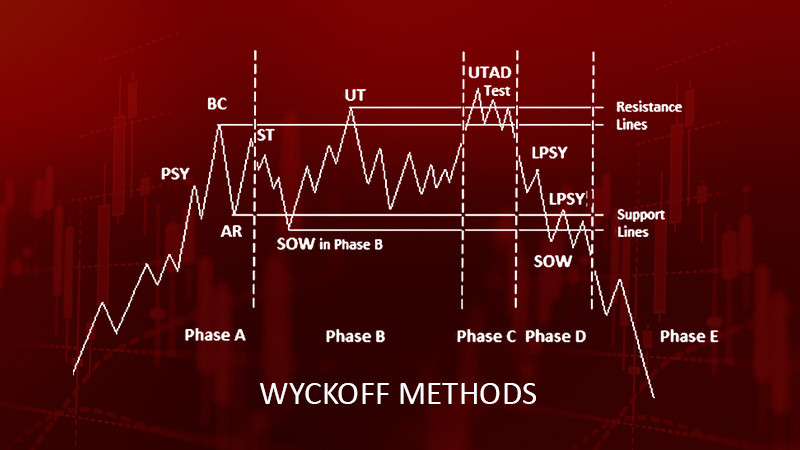
Anyone who has ever invested or traded in financial markets knows how crucial it is to understand and forecast market movements. For most beginners, the world of trading appears chaotic, unpredictable, and complex. However, years of research have led experts and professionals in the field to develop various methods and approaches that enable a certain level of confidence in predicting future market behavior.
Also, check out the article "Trading Methods".
One of the most respected and time-tested methods is the Wyckoff Method, developed by Richard D. Wyckoff in the early 20th century. What sets this method apart? It offers a unique perspective on the market, focusing on the actions of its most influential participants: large investors, corporations, and financial institutions.
Instead of viewing the market as an abstract collection of charts and numbers, this strategy suggests seeing it as a battleground of interests, strategic decisions, and, most importantly, the opportunity to understand and anticipate the moves of the market's "big players" or "whales."
At a time when many traders rely on complex mathematical models or automated systems, this theory suggests a return to basics — understanding what truly drives the market. It is an approach grounded in the psychology, behavior, and strategies of real people behind the charts.
In the modern world of trading, where technology and algorithms play a key role, it might seem like old methods are losing relevance. However, this effective strategy continues to be in demand. This is not surprising, as it is based on a deep understanding of market patterns and mechanisms that remain constant even through centuries.
Today, we will delve into the fascinating world of the Wyckoff Method. We will learn about its core principles, strengths, and weaknesses, and how it can be applied in current conditions. If you are looking to enhance your trading skills, gain a deeper understanding of the market, or just broaden your financial knowledge, this overview is definitely for you.
This is one of the most unique and insightful approaches to analyzing financial markets. Its ideas are based on a simple yet profound truth: key market movements are determined by the actions of the largest participants, often referred to as smart money or whales.
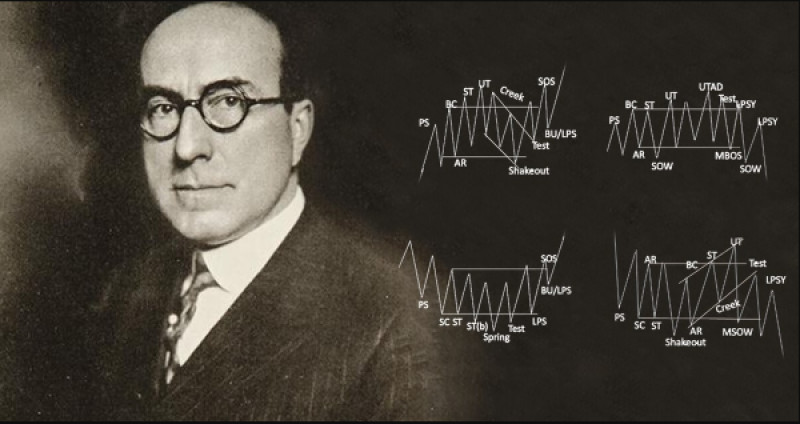
The philosophy of the method is the following. In the early 20th century, American investor Richard Demille Wyckoff concluded that most small investors suffer losses due to their inability to understand the actions of major players. He believed that if individual investors could read and interpret the actions of experienced investors, they would be better positioned to make decisions about buying or selling assets.
Volume and price analysis: The cornerstone of the Wyckoff Method is the combined analysis of price charts and trading volumes. Wyckoff argued that price and volume together provide the most accurate picture of market activity. By studying the relationship between price changes and trading volume, one can determine whether an asset is in a phase of accumulation (bought by large players) or distribution (sold by large players). Let's look at Wyckoff's accumulation and distribution schemes.
Wyckoff identified four main phases of the market cycle:
- Accumulation: This is when whales actively buy or accumulate assets, often after a prolonged decline.
- Growth: This stage sees the asset's price start to rise, following the completion of the main accumulation phase.
- Distribution: Here, whales begin selling or distributing their assets after a growth period.
- Decline: At this stage, assets decrease in price, starting after the main distribution period.
- Understanding the Major Players: This approach does not just focus on prices and volumes, but also on the psychology of the market's biggest players. Understanding their motives, strategies, and actions allows traders to adapt and respond accordingly.
The Fundamental Assumption: The method is based on the assumption that major players always act with a specific purpose, and their actions can be interpreted through the analysis of market charts and data.
In conclusion, this is not just a set of technical indicators or graphical patterns. It is a philosophy, an approach to understanding the market from the perspective of its most powerful participants. Those who master this method unlock a new dimension in market understanding, which can be a game-changer in their trading career.
Wyckoff's Three Laws
Developed by Richard Wyckoff in the early 20th century, this approach is a cornerstone of technical analysis. It is built on three key laws that help investors and traders understand the actions of major market participants. Let's explore these three laws in more detail:
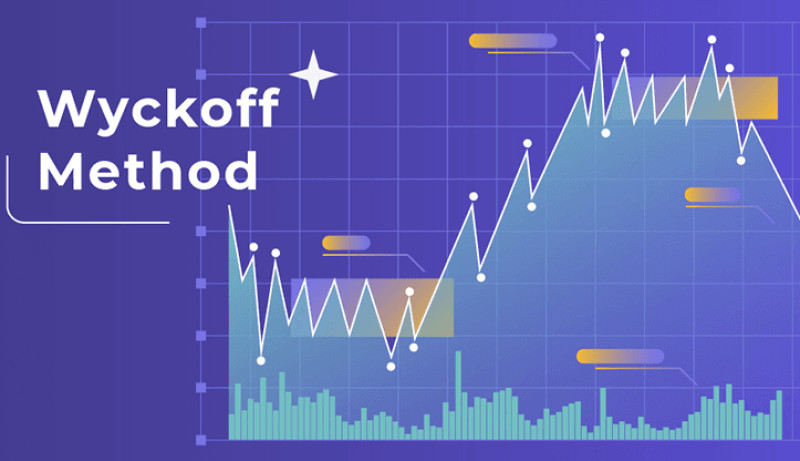
Law of Supply and Demand
This law is the heart of the entire financial market. It's based on a basic economic concept: when demand exceeds supply, prices rise; when supply exceeds demand, prices fall. In the stock market, this manifests in the activities of major players — when they are actively buying (high demand), stock prices go up. When they are selling (high supply), prices go down.
Understanding this law allows traders to determine which direction the trend will move. Trading volume analysis can aid in this: an increase in volume with rising prices indicates a dominance of demand, while an increase in volume with falling prices indicates a dominance of supply.
Law of Cause and Effect
This law states that every significant market movement (effect) has a specific cause. The most common causes are accumulation or distribution phases. During the accumulation period, major players actively buy assets, laying the groundwork for a future upward trend. During the distribution period, these players begin selling their assets, leading to the start of a downward trend.
It is crucial to understand that these market phases can last quite a while, and the market won't move significantly up or down until one of these phases is completed.
Law of Effort and Result
This law suggests that changes in trading volumes should match changes in prices. For example, if asset prices are rising on high volumes, it indicates that the effort (high volume) matches the result (price increase). However, if prices rise or fall on low volumes, it may signal a mismatch between effort and result, hinting at a possible trend change.
In conclusion, Wyckoff's three laws offer a powerful tool for understanding market dynamics. They provide traders and investors with a structured framework for interpreting the actions of major market players, which can be a catalyst for making informed and mindful market decisions.
Trading strategies according to Wyckoff method
This approach not only provides a theoretical understanding of the market but also specific schemes for identifying optimal entry and exit points. These schemes are based on an in-depth analysis of market cycle phases and the actions of major players. Let's explore the key strategies:
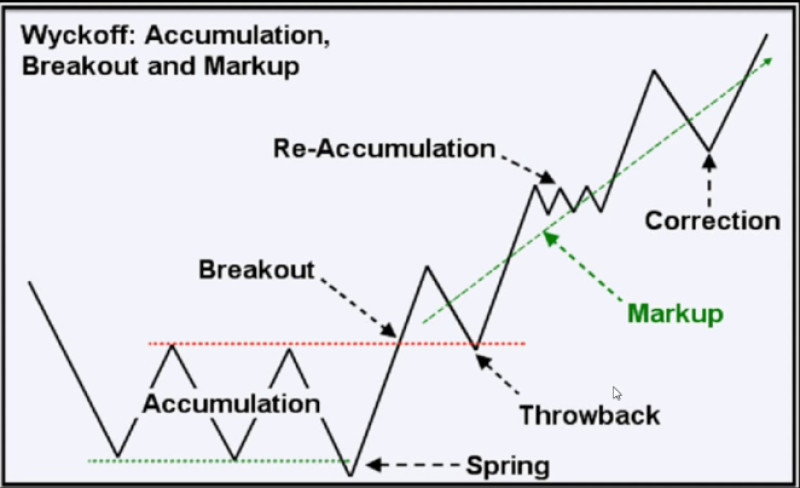
• Accumulation phase
Box breakout: This scenario occurs when the price moves out of a long-term range (box) where it has been for an extended period. A breakout of the upper boundary of the box on high volume can signal the start of an upward trend.
Support testing: After establishing a lower pressure point, the price may return to this zone to test it. If there's no breakthrough on low volume, this could be a good buying point.
• Growth phase
Countermove: Following a significant price rise, there could be a correction. If this correction occurs on low volume, it might suggest a temporary pullback, not the end of the trend.
Resistance Breakthrough: If the price overcomes the resistance zone on high volume, this could be a signal to buy or strengthen your position.
• Distribution Phase
Peak Formation: After a long period of price growth, the market might start forming a peak. If this process is accompanied by an increase in selling volume, it could signal the start of the distribution phase.
Support Breakdown: A downward break of the support level on high selling volume could indicate the beginning of a downward trend.
• Decline Phase
Pullback to Resistance: Following a decline, the price might pull back to a previous support level, which now becomes resistance. If this pullback happens on low volume and fails to break this level, it could be a good point for selling.
The core principle of trading using the Wyckoff Method is to align with the actions of major players, rather than going against them. Understanding and correctly applying these patterns helps traders maximize profits and minimize risks.
Successful use of these patterns requires practice and continuous learning. It is also important to integrate Wyckoff's patterns with other technical analysis tools and consider fundamental factors to get a complete picture of the market.
Wyckoff method application
This method, conceived in the early 20th century, remains a relevant tool in technical analysis today. Crafted with an understanding of the maneuvers of major market players, it offers traders and investors a unique perspective on the market. Its application involves several key aspects:

Volume Analysis: A cornerstone of the Wyckoff method is the analysis of trading volume. By examining the relationship between volume and price movements, traders can discern when major players are entering or exiting the market.
Market Phase Identification: The method categorizes market cycles into four main phases – accumulation, uptrend, distribution, and downtrend. By identifying the current phase, traders can anticipate the market's next likely direction.
Seeking Hidden Gems: Wyckoff advised looking for stocks in the accumulation phase poised for growth. These stocks often lag the overall market but hold high growth potential.
Utilizing Patterns: Various Wyckoff trading schemes, like a 'box breakout' or 'support testing,' are used to pinpoint optimal entry and exit points.
Combining with Other Methods: While potent on its own, this method's effectiveness is enhanced when combined with other technical and fundamental analysis methods.
Application Across Timeframes: The tool is adaptable for both long-term and short-term charts, making it versatile for traders of different styles.
Learning and Practice: Successful application requires not just learning the basics but also regular practice. Analyzing past market movements using the Wyckoff method can help traders refine their forecasting skills.
Implementing the Wyckoff method demands not only a grasp of its fundamentals but also critical thinking and analysis. Proper utilization can afford traders and investors a significant edge in the market, aiding them in better understanding the actions of major players and adjusting their strategies accordingly.
Accuracy of strategy
This approach undoubtedly boasts a unique structure and principles, providing investors and traders with a tool to decipher market movements. However, like any strategy or methodology, its effectiveness is not guaranteed. Let's explore the accuracy of the Wyckoff strategy and the factors influencing this.
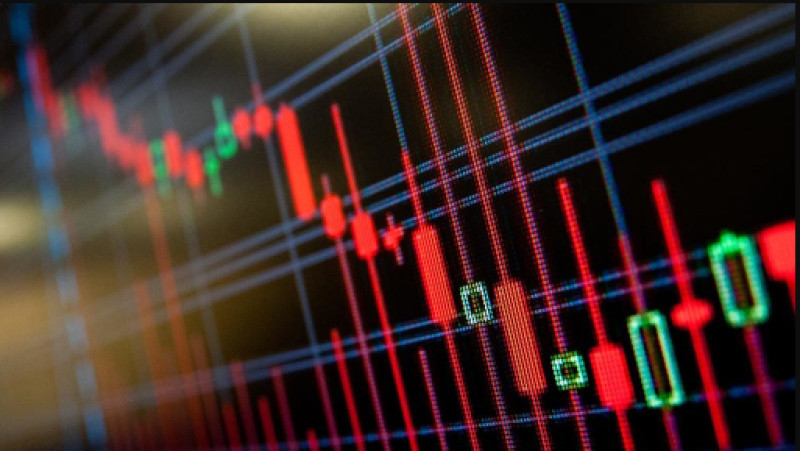
Real Data Foundation: The Wyckoff method is grounded in real market data, such as prices and trading volumes, making it relevant and applicable for analyzing any financial market.
Dependence on Interpretation Quality: The strategy's accuracy largely hinges on the trader's ability to interpret data correctly. Understanding market cycle phases or analyzing volumes demands expertise and insight.
External Factors: Fundamental news or global events can abruptly alter market direction, potentially reducing the accuracy of predictions based on the Wyckoff method. This underscores the importance of blending technical analysis with fundamental analysis.
Volatility of Major Players: The approach is predicated on tracking the actions of major players. However, their strategies may change, and they might not always act rationally or predictably.
Adapting to Market Changes: Like many other methods, the Wyckoff strategy requires continuous adaptation to evolving market conditions. What worked in the past may not yield results presently.
Subjectivity in Decision-Making: Despite its structured approach to analysis, many aspects of the Wyckoff method involve subjective interpretation, which can impact the trader's final decision.
Combining with Other Strategies: For enhanced accuracy, many traders integrate this approach with other strategies or indicators for a more comprehensive market understanding.
While a powerful market analysis tool, its precision largely depends on the trader's skills, experience, and adaptability to changing conditions. Like any strategy, it is not a magic pill and should be used with caution, risk consideration, and continuous learning.
Composite operator
Grasping the concept of the Composite operator is crucial for mastering the Wyckoff method. This term encapsulates the collective actions of all major investors and traders in the market. Let's delve deeper into this concept.
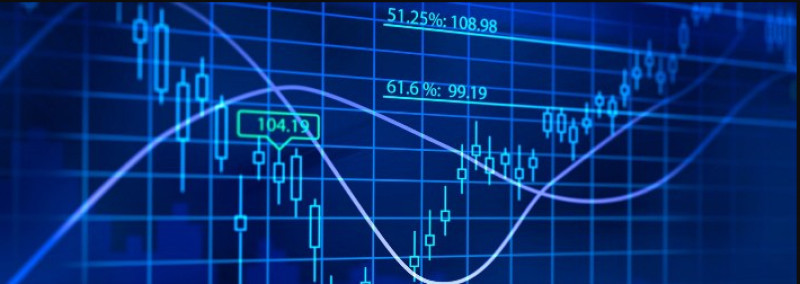
What is the Composite operator? Richard Wyckoff introduced the Composite Man as a metaphorical figure representing the collective actions of the market's biggest players. This abstract entity wields significant capital, enabling it to influence market movements.
Why is it Important? The concept simplifies understanding market movements. Instead of analyzing each major player's actions individually, traders can focus on discerning the actions of this average or composite participant.
Actions of the Composite operator: In the Wyckoff method, the Composite Man's actions are often linked with the primary stages of the market cycle: accumulation, uptrend, distribution, and downtrend. Understanding which phase the Composite operator is operating in can assist in forecasting subsequent market movements.
Volume Analysis: A key method to observe the Composite operator's actions is through trading volume analysis. Large market operations often coincide with significant volumes, signaling the activity of major players.
Strategy Application: Successful traders and investors using this method often try to "ride the wave" with the Composite operator, aligning with its actions to capitalize on the movements.
Understanding Motives: While the Composite operator is an abstract concept, comprehending the potential motives behind its actions can offer an edge. For instance, if the market is in an accumulation phase, it can be inferred that the Composite Man is amassing assets in anticipation of growth.
Practical Application: Employing the Composite operator concept in practice demands skill in reading market signals and accurately interpreting price and volume dynamics.
In conclusion, the notion of the Composite operator is central to the Wyckoff method. It allows traders and investors to streamline their decision-making process by focusing on the actions of the market's major participants, aiming to maximize benefits from these insights.
Wyckoff method's pros and cons
This is a distinctive tool for market analysis, built on the understanding of the actions of major market participants and stages of the market cycle. Like any trading strategy or analysis method, it has its strengths and weaknesses. Let's delve into them.

Advantages:
In-depth Market Analysis: The Wyckoff method equips traders with the tools to understand the primary forces driving the market, enabling them to forecast future price movements based on current market behavior.
Price and Volume Combination: Unlike many other technical strategies, this method integrates both price and volume analysis, enhancing its efficacy.
Versatility: It can be applied across various markets (stocks, commodities, cryptocurrencies) and on different time frames.
Risk Mitigation: Understanding the market cycle phases and the actions of the Composite Man helps traders avoid buying during the distribution phase or selling during the accumulation phase, reducing potential losses.
Educational Value: Learning the Wyckoff method hones analytical skills and teaches traders to read the market through the lens of major players.
Disadvantages:
Complexity: For beginners, the method can seem challenging, requiring time to learn and understand its principles.
Subjectivity: Many elements of the Wyckoff method require subjective interpretation, which can lead to forecasting errors.
Dependence on Major Players: Since the method focuses on the actions of major market participants, it might overlook sudden changes caused by external factors or actions of smaller traders.
Need for Combination: To improve prediction accuracy, traders often need to combine this approach with other indicators or techniques.
Reactivity: This approach is based on reacting to past market actions, rather than predicting future movements, which can lead to delays in responding to some market movements.
In conclusion, this is a potent tool for those aiming to understand and forecast market movements. However, like any tool, it requires deep understanding and correct application. Despite its drawbacks, for many traders, the benefits of the method make it an integral part of their trading strategy.
Conclusion
The aforementioned approach is undoubtedly one of the most fundamental and profound methods for analyzing market movements. Based on understanding the actions of major market players and the successive stages of the market cycle, this method provides traders with a unique opportunity to read the market and predict its behavior.
The main strength of this method lies in its ability to identify potential market turning points and specific phases of the market cycle. This analysis, which combines price dynamics and trading volumes, allows investors and traders to optimize their trading decisions based on a deep understanding of market mechanisms.
However, like any analytical method, the Wyckoff method has its drawbacks. Its relative complexity can be a formidable barrier for beginners. The requirement for subjective analysis can also lead to interpretation errors, especially without proper experience and understanding.
Nonetheless, for those willing to invest time and effort in mastering this method, the potential benefits can be immense. Many successful traders use the principles of Wyckoff as the foundation of their trading strategies, proving their effectiveness in practice.
A key aspect of employing the Wyckoff method is the necessity to combine it with other tools and methods of analysis to achieve maximum effectiveness. It works best in synergy with other approaches, allowing traders to create a multifaceted, flexible, and adaptive trading system.
It is important to acknowledge that in the ever-changing market conditions, this tool, like any other method, cannot guarantee 100% success. However, its principles, based on observations of the market over decades, offer a stable and time-tested approach to trading.
In conclusion, this method is a powerful combination of technical and psychological market analysis. For those aiming for a deep understanding of market mechanisms and the development of an effective trading strategy, it can become an invaluable tool.
You may also like:









 Back to articles
Back to articles



